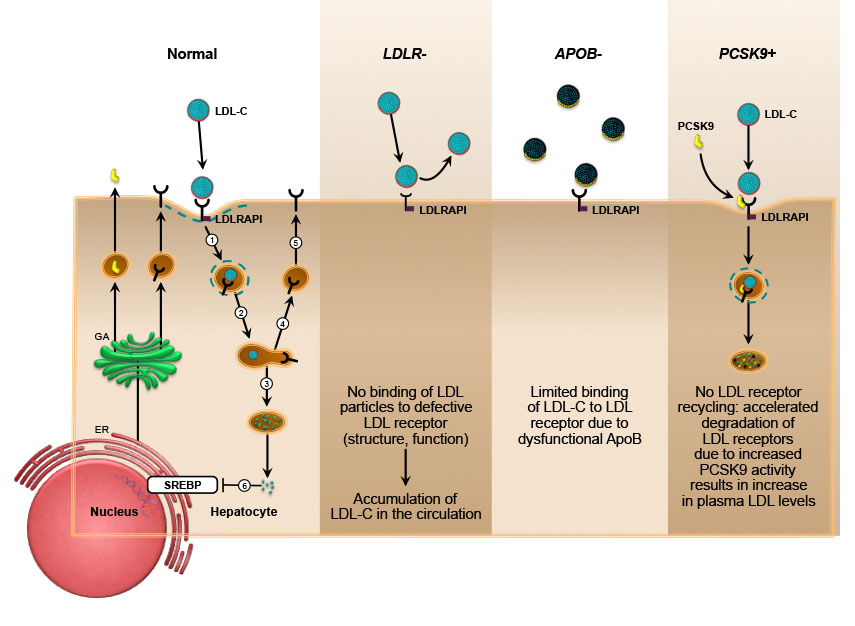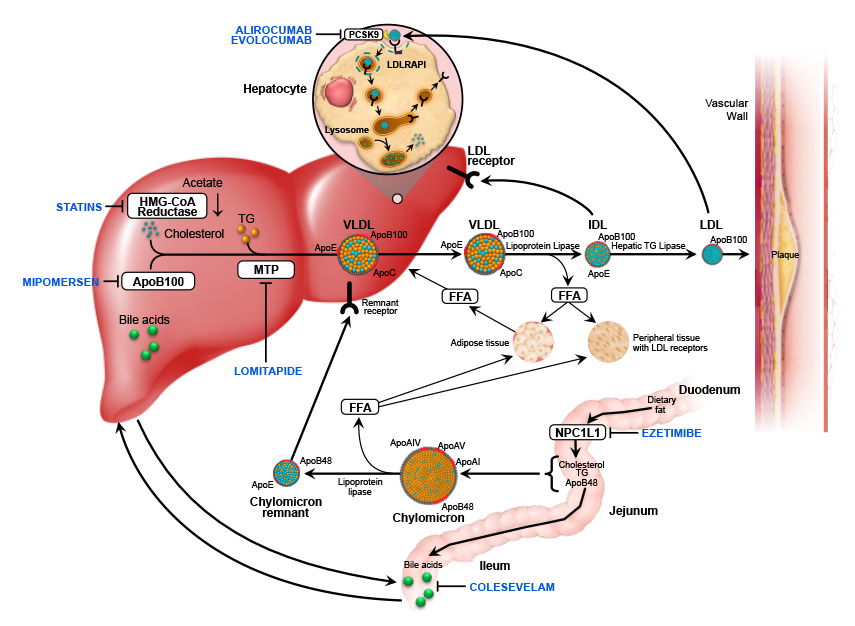Familial Hypercholesterolemia

Molecular basis of familial hypercholesterolemia with dominant pattern of inheritance: impaired low-density lipoprotein cholesterol clearance due to variations in LDLR, APOB, PCSK9.

LDL receptor-mediated regulation of low-density lipoprotein cholesterol levels and recommended drugs that affect various steps of these pathways.
Familial hypercholesterolemia (FH) is an autosomal dominant disorder characterized by a high plasma level of low-density lipoprotein cholesterol (LDL-C).
Familial hypercholesterolemia is associated with dramatically increased lifetime risk of premature atherosclerotic cardiovascular disease (ASCVD). Most available prevalence estimates state that familial hypercholesterolemia affects from 1 in 200 to 1 in 500 people.
Novel lipid-lowering drug classes approved for clinical use in the United States for the treatment of FH include:
- Antisense oligonucleotide to ApoB (mipomersen)
- Microsomal triglyceride transfer protein (lomitapide)
- Monoclonal antibodies to PCSK9 (alirocumab, evolocumab)
A summary of the current evidence for managing patients with FH, including screening, diagnosis, treatment and surveillance, can be found in Safarova MS, Kullo IJ. My Approach to the Patient With Familial Hypercholesterolemia. Mayo Clin Proc. 2016;91(6):770-86. PMID: 27261867.
Study 1: CASCADE registry
People suspected of having FH can enroll in a nationwide registry of FH patients, Cascade Screening for Awareness and Detection of Familial Hypercholesterolemia (CASCADE), through a patient portal in the CASCADE FH Registry.
Study 2: Mayo SEARCH eAlgorithm: Mayo Screening Employees And Residents in the Community for Hypercholesterolemia Study
Although recent advances in genomics have improved understanding of the genetic basis of high cholesterol and new drugs are available for treatment of these high-risk patients, there are substantial knowledge gaps in prevalence, awareness and control of familial hypercholesterolemia.
To overcome these barriers, our team in the Atherosclerosis and Lipid Genomics Laboratory aims to develop an automated method to rapidly identify cases of familial hypercholesterolemia in electronic health records (EHRs).
We are developing an electronic phenotyping algorithm for rapid identification of FH cases in EHRs to address knowledge gaps in prevalence, awareness and control of FH. The algorithm will facilitate early detection and prevention of adverse ASCVD outcomes in patients with FH.
In pursuit of developing strategies for early detection and prevention of adverse ASCVD outcomes in patients with FH, our lab created an ePhenotyping platform based on validated clinical criteria for FH diagnosis.
Related publications
- Safarova MS, Liu H, Kullo IJ. Rapid identification of familial hypercholesterolemia from electronic health records: The SEARCH study. J Clin Lipidol. 2016 Sep-Oct;10(5):1230-9. PMID: 27678441
- Safarova MS, Kullo IJ. My approach to the patient with familial hypercholesterolemia. Mayo Clin Proc. 2016 Jun;91(6):770-86. PMID: 27261867.
- Safarova MS, Liu H, Arruda-Olson A, Rastegar M, Smith C, Cheng Y, Balachandran P, Sohn S, Kullo IJ. Mayo Clinic. Electronic health record-based phenotyping algorithm for familial hypercholesterolemia. PheKB; 2016.
- Safarova MS, Mehrabi S, Liu H, Kullo IJ. An electronic phenotyping algorithm to rapidly ascertain familial hypercholesterolemia in health care systems: preliminary data. J Clin Lipidol. 2015;9(3):426-7. Presented at the National Lipid Association Scientific Sessions (Chicago, Illinois).
- Safarova MS, Liu H, Kullo IJ. Rapid identification of familial hypercholesterolemia from electronic health records. Circulation 2015; 132: A16554. Presented at the American Heart Association Scientific Sessions (Orlando, Florida).
- IJ Kullo. PCSK9 inhibition: A Game Changer in Cholesterol Management. CardiovascularUpdate: Cardiology, Pediatric Cardiology, and Cardiovascular Surgery News. 2015;13(3):1-2.
- Safarova MS, Kullo IJ. Family, cholesterol and the genes from the ground up or why screening matters. Atlas of science. 2016.